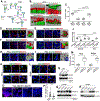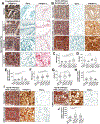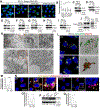Targeting the ATF6-Mediated ER Stress Response and Autophagy Blocks Integrin-Driven Prostate Cancer Progression
- PMID: 37314749
- PMCID: PMC10527559
- DOI: 10.1158/1541-7786.MCR-23-0108
Targeting the ATF6-Mediated ER Stress Response and Autophagy Blocks Integrin-Driven Prostate Cancer Progression
Abstract
Prostate cancer progression to the lethal metastatic castration-resistant phenotype (mCRPC) is driven by αv integrins and is associated with Golgi disorganization and activation of the ATF6 branch of unfolded protein response (UPR). Overexpression of integrins requires N-acetylglucosaminyltransferase-V (MGAT5)-mediated glycosylation and subsequent cluster formation with Galectin-3 (Gal-3). However, the mechanism underlying this altered glycosylation is missing. For the first time, using HALO analysis of IHC, we found a strong association of integrin αv and Gal-3 at the plasma membrane (PM) in primary prostate cancer and mCRPC samples. We discovered that MGAT5 activation is caused by Golgi fragmentation and mislocalization of its competitor, N-acetylglucosaminyltransferase-III, MGAT3, from Golgi to the endoplasmic reticulum (ER). This was validated in an ethanol-induced model of ER stress, where alcohol treatment in androgen-refractory PC-3 and DU145 cells or alcohol consumption in patient with prostate cancer samples aggravates Golgi scattering, activates MGAT5, and enhances integrin expression at PM. This explains known link between alcohol consumption and prostate cancer mortality. ATF6 depletion significantly blocks UPR and reduces the number of Golgi fragments in both PC-3 and DU145 cells. Inhibition of autophagy by hydroxychloroquine (HCQ) restores compact Golgi, rescues MGAT3 intra-Golgi localization, blocks glycan modification via MGAT5, and abrogates delivery of Gal-3 to the cell surface. Importantly, the loss of Gal-3 leads to reduced integrins at PM and their accelerated internalization. ATF6 depletion and HCQ treatment synergistically decrease integrin αv and Gal-3 expression and temper orthotopic tumor growth and metastasis.
Implications: Combined ablation of ATF6 and autophagy can serve as new mCRPC therapeutic.
©2023 American Association for Cancer Research.
Conflict of interest statement
Figures







References
-
- Kellokumpu S, Sormunen R, Kellokumpu I. Abnormal glycosylation and altered Golgi structure in colorectal cancer: dependence on intra-Golgi pH. FEBS Lett 2002;516:217–24 - PubMed
Publication types
MeSH terms
Substances
Grants and funding
LinkOut - more resources
Full Text Sources

